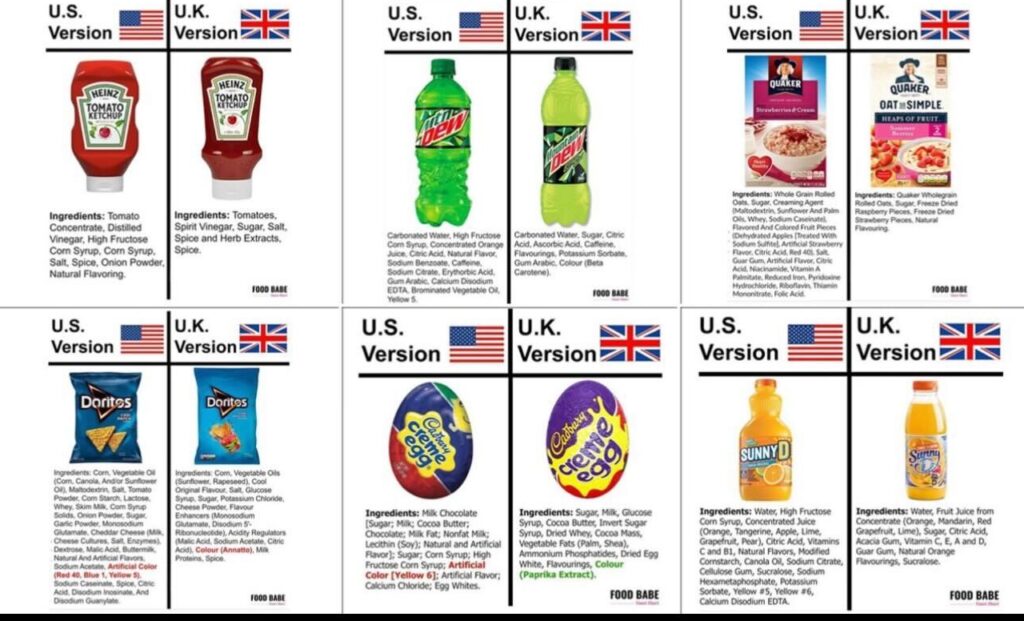If you compare the list of ingredients in many of the packaged foods sold in the U.S. to their counterparts in the U.K., you will notice a few striking differences. That’s because European nations have outlawed the sale and distribution of various artificial ingredients that have been known to increase the risk of cancer, including preservatives, chemicals, and food dyes used in pre-made baked goods, chips, sweets, and popular candies.
Food blogger Vani Har shared an infograph that highlights the differences in how these foods are made in different parts of the world. She accused major food distributors of “poisoning consumers for profit.”
“Although artificial dyes are common in America, that doesn’t make them safe to eat,” Vani wrote on her blog. “Companies don’t want to slap warnings all over food packages because that wouldn’t be good for business. To make matters worse, they add high fructose corn syrup, cellulose gum, and artificial preservatives to the U.S. version.”
These chemicals are notably absent from the U.K. versions. Vani said U.S. companies continue to use them because “they are cheaper to produce” than natural dyes, spices, and other ingredients.
For example, Doritos in the U.S. use Red 40 to give each chip its signature color. The dye is a “certified color that comes from petroleum distillates or coal tars,” according to the U.S. Food and Drug Administration. It contains p-Cresidine, which the U.S. Department of Health Human Services calls a “reasonably anticipated” carcinogen in humans. Artificial food colorings can also cause allergic reactions in some individuals.
These differences can also be found in Mountain Dew. In the U.S., PepsiCo, which manufactures the drink, uses Yellow 5 to give the soda a yellow-green tint. Yellow 5 is a petroleum-based dye known as Tartrazine. Compare that to the U.K. version, which uses beta carotene, a natural color derived from carrots and other orange/yellow foods.
“In some cases, food-processing companies will reformulate a food product for sale in Europe” but continue to sell the product with the additives in the United States, said Lisa Y. Lefferts, senior scientist at the Center for Science in the Public Interest, a food safety advocacy organization.
Here’s a list of all the substances that have been banned in Europe but not the U.S.:
- Potassium Bromate and Azodicarbonamide (ADA)
These are additives commonly used to make baked goods, but they were banned in Europe because they may cause cancer.
Potassium bromate is often added to flour because it helps the dough rise higher while giving it a white glow. It is listed as a possible carcinogen by the International Agency for Research on Cancer. The 1958 Delaney Amendment to the Food, Drug and Cosmetic Act in the U.S. gives the FDA the authority to ban the sale of ingredients that may cause cancer, but ingredients that were in use before the passage of the amendment cannot be banned because they had prior approval and “therefore are not regulated as food additives.”
ADA is a whitening agent added to flour that acts as a dough conditioner. It breaks down during baking into chemicals known to cause cancer in lab animals. The FDA says ADA is safe to consume in small amounts, but it is also found in some yoga mats.
- Brominated Vegetable Oil (BVO)
BVO is an additive used in a variety of soft drinks, including Mountain Dew, to prevent ingredients from separating. Bromine is found in brominated flame retardants, and research shows large amounts can lead to memory loss, skin, and nerve problems. The FDA says it is safe in limited amounts.
- Yellow 5 and 6, Red 40
These are artificial food dyes added to a variety of food products sold in the U.S. The FDA acknowledges that they can cause allergic reactions but that such reactions are rare.
“They’re used in so many things you wouldn’t even think of, not just candy and icing and cereal, but things like mustard and ketchup,”said Lefferts, a food safety scientist, as well as marshmallows, chocolate, oatmeal and breakfast bars that appear to contain fruit.
While these ingredients can be found in many processed foods sold in the U.S., advocates like Har are putting pressure on companies to put labels on these products to help consumers stay in the know. She is also getting some companies to remove these ingredients from their products. Subway famously removed azodicarbonamide from its bread products after Har called them out on social media. Pay attention to what’s in your food to avoid eating something you might regret.





